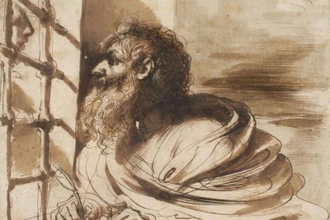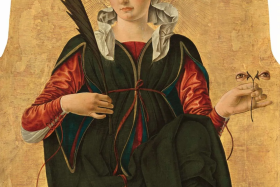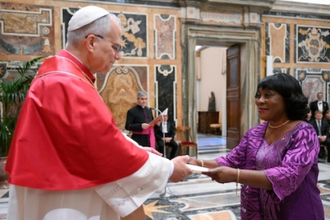Gospel in Art: The hour is coming when I shall no longer speak to you in metaphors

The Rule of Death, by Johann Jacob Ridinger after Johann Elias Ridinger 1760 © Christie's New York, 3.11.16.
Source: Christian Art
Gospel of 20 May 2023
John 16:23-28
Jesus said to his disciples:
'I tell you most solemnly, anything you ask for from the Father he will grant in my name.
Until now you have not asked for anything in my name. Ask and you will receive, and so your joy will be complete.
I have been telling you all this in metaphors, the hour is coming when I shall no longer speak to you in metaphors; but tell you about the Father in plain words. When that day comes you will ask in my name; and I do not say that I shall pray to the Father for you, because the Father himself loves you for loving me and believing that I came from God.
I came from the Father and have come into the world and now I leave the world to go to the Father.'
Reflection on the mezzotint
Jesus uses the word 'metaphor' twice in toady's reading. Jesus was indeed teaching in parables, allegories and metaphors, all in order to communicate broader spiritual truths to us. Metaphors run throughout Scripture, already being very prolific in the Old Testament (for example Isaiah 64:8: 'We are the clay, and You our potter', where God is compared to a potter and we are the clay; or Psalm 23:1: 'The Lord is my shepherd', where God is compared to a shepherd, someone whose duty it is to look after his sheep). Jesus continues this tradition. Think of 'I am the bread of life' or ''I am the Light of the world' or 'I am the vine; you are the branches'… we are all very familiar with these metaphors, and they truly help us grasp the most complex theological truths in a very simple way.
In our reading Jesus says that now the time has come for him to stop talking in metaphors. The end of the reading gives us a clue as to why. He says of himself, 'I came from the Father and have come into the world and now I leave the world to go to the Father'. There is a sense in which it would be true to say that what Jesus says of himself there applies to all of us. We have come from the Father into the world when we are born and we will leave the world and go back to the Father. In between this coming into the world and leaving it we are called to be in a deeply personal relationship with God the Father, through his Son, and living in the Spirit.
Art uses visual metaphors too: an image that the viewer is meant to understand as a symbol for something else. Visual metaphors can be obvious, hidden, subtle, humorous, or scathing, but they form a nexus of imagery that artists have used across the centuries to help communicate information without words: storms to symbolise danger, crows to symbolise death, hourglasses representing the passage of time, butterflies to symbolise personal transformation, etc….
Our 18th-century engraving depicts a myriad of metaphors featuring a grinning skeleton, crowned with a winged hourglass, sitting on drapery above a pile of war trophies (pieces of body armour, a shield and a sword). We also see an imperial orb and a crown, a mitre, legal documents, a book and a painter's palette. With an arrow the skeleton points at a stone tablet, into which the following words are cut: 'OMNIA MIHI SUBDITA'. Death declares his rule: 'Everything succumbs to me'. But as the spoils at his feet imply, it is not just all living things that must die. Power and glory, military might and honour, art and learning will also perish under his rule. It is a rather grim print filled with metaphors, but very gripping nevertheless.
LINKS
Gospel in Art: https://christian.art/
Today's reflection: https://christian.art/daily-gospel-reading/john-16-23-28-2023/


















